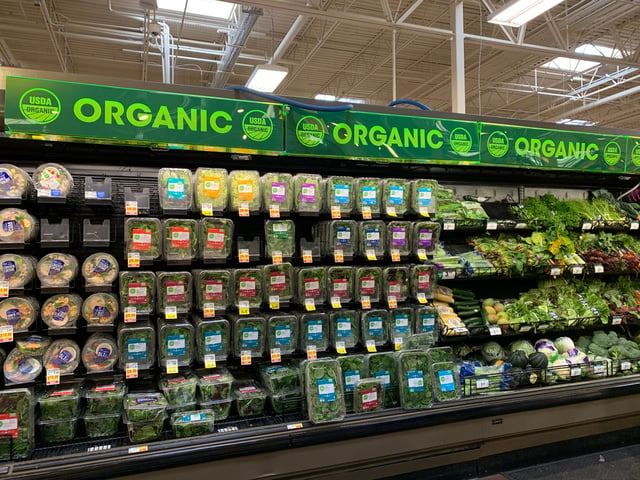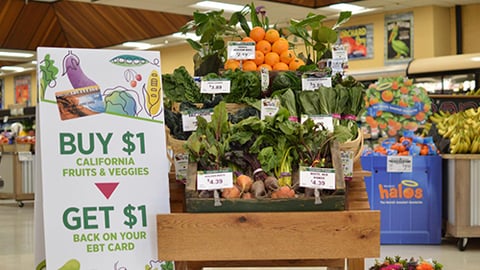Conventional Produce Dollars Edge Out Organic in Q1: Report
Ongoing inflation continued to affect organic fresh produce sales in the first quarter of 2023, as overall dollar sales grew by slightly less than 1%, and volume declined by 3.4%, from the same year-over-year period, according to the “Q1 2023 Organic Produce Performance Report” released by Organic Produce Network (OPN) and Category Partners.
As consumers look for ways to cut their grocery bills, they may be choosing to pass over higher-priced fruits and vegetables. OPN found that conventional produce dollars rose higher than organic dollars by about 2% and declined in volume by a smaller degree than organic. The average price gap between conventional and organic is now the largest it has been in the last four years.
[Read more: "How the Mexican Avocado Industry is Helping Protect the Environment"]
“In an inflationary period, we see this standard of growth for dollars and decline for volume repeated for most organic and conventional items. When we look at pricing, conventional produce average price per pound grew by 4.3% compared to the first quarter of 2022, while organic produce average price per pound rose by 4%,” said Tom Barnes, CEO of Idaho Falls, Idaho-based Category Partners. “With rising prices, we may be seeing more selective organic shopping from consumers as they substitute conventional items for higher-priced organic items.”
Organic tomatoes were the most noticeable example of substitution, as their price per pound increased by almost three times the amount of conventional, resulting in a volume decline of 8%. Most other categories with large differentials in price increase (compared were conventional) did not see large drops in organic volume.
OPN noticed that organic grapes had an incredible quarter, with a 37.3% increase in volume and a 40.2% increase in dollars. The first quarter is deep into the import season for grapes. Imported organic grapes are closing in on entering the top 20 organic categories in Q1, with $22 million in sales for the quarter this year, which places them in the 22nd spot by dollars. A 40% increase in dollars and a 37% increase in volume mean that import grapes are a category to keep an eye on.
Prepackaged salads and the berry category (strawberries, raspberries, blueberries and blackberries) led the quarter as the top organic produce categories in dollars, accounting for nearly 40% of all sales.
According to OPN, current trends show both conventional and organic produce volume shrinking year over year. At the same time, while volume for conventional produce is below 2020 and organics are on par with 2020, both are consistently gaining in dollars. For the first quarter of 2023, half of the leading 20 organic categories posted increases in dollars. Organic onions generated the largest percent increase in dollars, at 10%, followed by bell peppers, lettuce and herbs. Meanwhile, avocados posted the largest decline in dollars. Apples also posted noticeable declines.
In the first quarter of this year, 15 of the leading 20 categories posted declines in volume, with only seven of those 15 categories displaying positive year-over-year dollar growth. Organic apples posted the largest year-over-year decline in volume (by total pounds) of the leading categories, followed by bananas and carrots.
Despite the flat dollar growth and minor decline in volume across the country, OPN co-founder and CEO Matt Seeley is bullish on the long-term prospects for growth of organic fresh produce. “Inflation and supply chain challenges have impacted pricing in the short term; however, organic fresh produce will remain an important component of weekly food shopping as consumers look for healthy, safe and nutritious products for their families,” he said.
Overall, OPN's report shows the total produce department gained 2.6% in dollars for Q1 2023 compared with the same period in 2022, and declined by 1.3% in volume. Sales of organic fresh produce totaled nearly $2.4 billion for the first quarter of 2023, while overall volume topped 703 million pounds.
The “Q1 2023 Organic Produce Performance Report” uses NielsenIQ syndicated data to track and report the performance of organic fresh produce — and specifically the 20 leading organic categories. It covers total food sales in the United States, including all outlets (i.e., supermarkets, mass merchandisers, club stores, dollar stores, convenience stores and military commissaries) over the months of January, February and March of this year.







